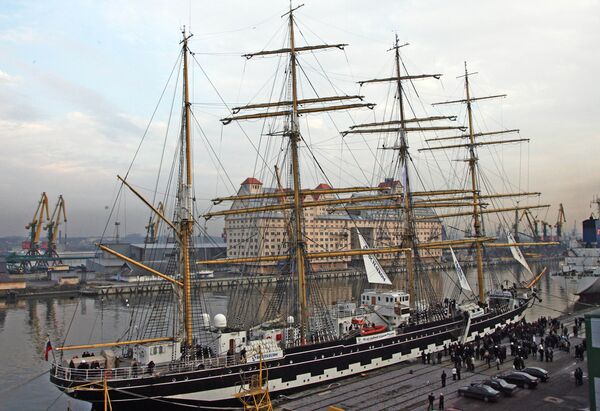The second leg of the international trans-Atlantic expedition involving Russia’s Kruzenshtern training four-masted barque is now underway. The ship has cleared the Panama Canal for the first time enroute to Vancouver, home to the upcoming Olympic Games, scheduled to be held on February 12–28, 2010.
Mikhail Novikov, the Captain of the Kruzenshtern, discusses the Panama Canal passage in this RIA Novosti interview.
Question: The Kruzenshtern has successfully sailed from the Atlantic Ocean into the Pacific Ocean. Did you have any problems passing the Panama Canal?
Answer: The Panama Canal is an international canal like the Suez and Kiel Canals. The procedure for passing the Panama Canal is stipulated by the Maritime Regulations for Transiting the Panama Canal, which has remained virtually unchanged in the past 90 years. The main problem was that our crew lacked the navigation experience of crossing the Panama Canal.
The Canal’s pilot service facilitates all ship crossings in order to avoid emergencies. It takes an average of nine hours to cross the Canal. The minimal time is 4 hours 10 minutes. We managed to fit somewhere in between.
The pilot was escorted by officers responsible for the Canal’s safety, including a young fragile girl who was an age mate of our women cadets who, together with the 120 cadets from the Baltic Fishing Fleet State Academy (BFFSA), the Kaliningrad, St. Petersburg and Volga-Caspian fishing fleet colleges, are undergoing training at our ship. I introduced them to each other and they got along well.
Q.: How should a sailing ship and her crew prepare for the Canal crossing?
A.: Preparations are essential. As I said earlier, the ship’s officers and crew lacked any prior navigation experience of passing the Canal. Consequently, the main preparations involved theoretical studies of the Maritime Regulations and the Canal chart. In addition, the crew practiced the passage of narrow sectors.
Q.: Could you describe the crossing?
A.: The Canal handles different types of vessels, including private yachts, tankers and container ships. "Panamax ships," the largest ships passing through the Panama Canal, virtually set ship configuration and gross-tonnage standards.
We navigated part of the waterway under engine power. When the Kruzenshtern approached the locks, four electric locomotives, or “mules” as they are called here, took us in tow. Split-second timing and safety were the main aspects of controlling the ship.
Navigation accuracy was plus-minus 10 minutes, as stipulated by the timeframe submitted by our agent. Daytime temperatures reached 35 degrees, while the temperature of seawater used for cooling the ship’s system was 28 degrees. Our engines were tested thoroughly, but even the pilots were worried. Due to the superb professionalism of our mechanics, the engines operated without a hitch for 9 hours non-stop.
There are three bridges across the Canal. Believe me, it is a good sign to pass under a bridge before entering the Pacific Ocean. This also allowed us to check the actual height of our masts.
As an exception, the administration of the Colon Seaport allowed us to take pictures and video footage of the Panama Canal in passing. These materials will help train navigators at our Academy.
After entering the Pacific Ocean, we adjusted the rigging and moved down south under sails alone. The crossing of the Canal shortened our route to Vancouver by almost 7,000 nautical miles.
Electric locomotives pulled Kruzenshtern toward Panama Canal locks – Novikov

© RIA Novosti . Igor Zarembo
/ Subscribe
The second leg of the international trans-Atlantic expedition involving Russia’s Kruzenshtern training four-masted barque is now underway. The ship has cleared the Panama Canal for the first time enroute to Vancouver, home to the upcoming Olympic Games, scheduled to be held on February 12–28, 2010.



